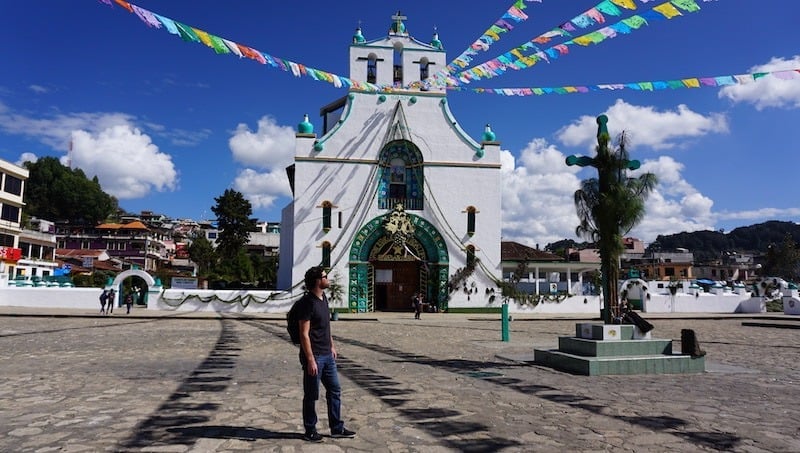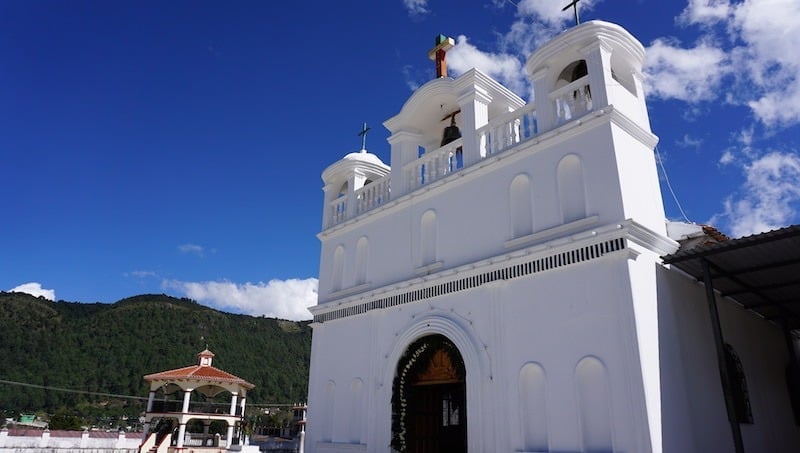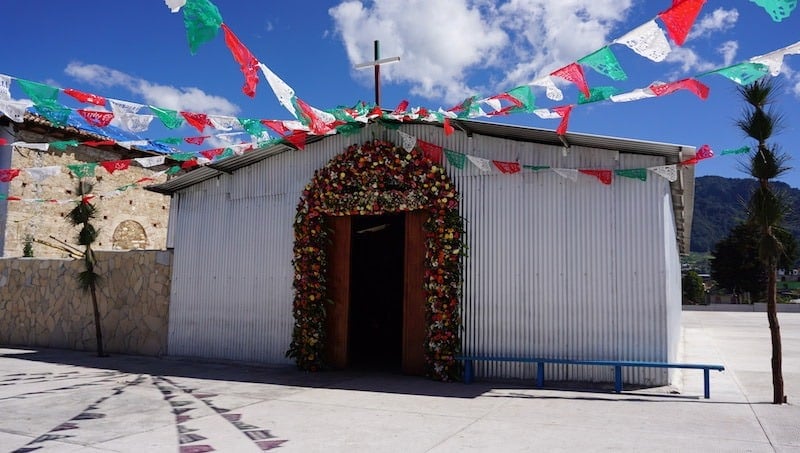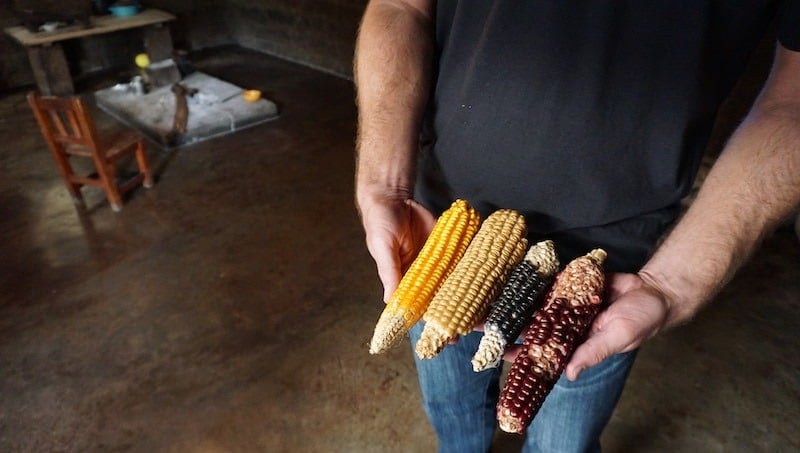A few rays of light shine through the misty haze, the pine needles below your feet soften your steps, and a chicken clucks a few feet away.
No, it’s not early morning on the farm. It’s the interior of the San Juan Bautista temple in Chamula.
This unique place of worship provides a hearty dose of culture shock that will rattle your senses and blow your mind.
A day trip to the indigenous towns of San Juan Chamula and San Lorenzo Zinacantan, known as Chamula and Zinacantan, is one of the best things to do when visiting San Cristobal de las Casas in Chiapas, Mexico.
Both towns are testaments to how the Tzotzil people have managed to retain many aspects of their prehispanic culture despite centuries of colonization and evangelization.
Visiting Chamula and Zinacantan is a must-do cultural experience!
We link to products and services we think are useful for our readers. We may earn a commission for purchases made through some of these links. There’s no extra cost for you and it helps support our work. We really appreciate your support!
The Best Way to Visit Chamula & Zinacantan
Chamula and Zincantán are both about a 25-minute car ride away from San Cristobal de las Casas in Chiapas, Mexico. You can easily get there by using any of the transportation options below, but the absolute best way is to take a guided tour. As you know, we usually avoid tours like the plague, but this is one of the very few times that I will insist you take a guided tour.
Why take a tour to Chamula and Zincantan? Because I’ve visited these villages twice, both with and without tours, and you won’t understand much about what is happening without a guide. These towns are autonomous and practice their own unique form of religious syncretism.
The first time I stepped into the Chamula temple was absolutely mind-blowing. But, without a guide, I had absolutely no clue what was happening, and I ended up with tons of questions and zero answers. Believe it or not, Google does not know everything! This time, I insisted we get a guide, and I finally got answers to all of my questions (sigh of relief).
You may be wondering what on earth could be happening inside that you require an explanation. I mean, it’s a church, right? Most people have been inside churches or at least know about what goes on inside them. People sitting in pews, praying, bla, bla bla.
Wrong! The San Juan Church in Chamula is its own mystical world full of chickens and chanting (keep scrolling for more on this).
Even though you can totally visit the church and town on your own if you want to understand what you’re encountering then make sure to take a guided tour to both towns from San Cristobal or at the very least hire one of the guides in the plaza to give you a tour of the temple once you are in Chamula.
➡️ Visiting Chiapas? Check out the Ultimate Chiapas Travel Guide for everything you need to know!

How to Get to Chamula from San Cristobal de las Casas
San Cristobal de las Casas in Chiapas is the closest city with hotels. We stayed there for over a month in a vacation rental, but there are also tons of great hotels on Booking.com.
By Colectivo: Catch a colectivo (shared van) near the produce market on Calle Honduras. There’s a clearly marked terminal with colectivos going to San Juan Chamula for $18 pesos. These will drop you off at the main plaza in San Juan Chamula, where the temple is located. From Chamula, you can either take a 1.5 hour walk or a colectivo to Zinacantan.
By Taxi or Car: Hire a private taxi to take you for about $100 pesos one way or rent a car.
San Juan Chamula Tours
We took and recommend a culturally-responsible tour to Chamula and Zinacantan with Alex y Raul. They speak English, Spanish, and even some Tzotzil (the indigenous language spoken in these towns).
By Foot: A hiking tour to Chamula is a fantastic way to take in the fresh mountain air and learn about the local culture.
By Horse: If you’re looking for something less strenuous, consider booking a horseback-riding tour to Chamula and Zinacantan.
For more options, take a look at the guided Chamula tours below.

Word of the Day: Syncretism
Before we continue, you need to learn a new word: syncretism. I don’t think we had ever heard of this word until we got to Chiapas. I’ll assume most of you haven’t either. Religious syncretism is the term for when two or more religions collide and form a hybrid.
You’ll need to know this to understand what is happening inside the Chamula church. Their religion is a unique combination of their ancestors’ prehispanic Maya belief system and Catholicism (which their ancestors were forced to convert to during Spanish colonization).
One example is that the Chamulans believe that saints are Jesus’ siblings and pray to different ones according to their specific needs. Much like their ancestors prayed to different gods for different requests. Anyway, back to the story…
San Juan Chamula
Since we hadn’t made reservations for the tour, we arrived at the Plaza de la Paz quite early. We quickly spotted a man who we intuitively knew was somehow part of the Alex y Raul Tours and we were right. He turned out to be our driver.
We waited for the rest of the group to arrive and the 5 of us piled into the van along with our guide, Cesar. It was a quick (about 20 minutes) and scenic ride to San Juan Chamula, through areas with wooden cabins, crops and lots of goats.
We were dropped off in front of an old, half-constructed church without a roof. It was surrounded by dead, brown pine tree branches on the ground. They looked to have been purposefully strewn about the area on top of dirt mounds and…headstones? Yep, it was a cemetery, but unlike any I had seen before.

Multi-colored Crosses and a Roofless Church
There were mounds rising from the ground and some had 2 or 3 colored wooden crosses at the head. Cesar, our guide, explained that the deceased could have multiple crosses here and that each color represented a different age group: white for babies, green or blue for children, and black for adults.
The now-dead pine branches had once been cut fresh and used to decorate the tombs during the recent Day of the Dead celebrations. The roofless church was one of many failed attempts by the Spanish to evangelize the town.

Who’s That in Jail?
From the cemetery, we walked over to the plaza and passed by the town market on the way. Right next to some market stands, there was a building with open rooms with bars. These were the town’s jail cells.
Chamula is an autonomous town with its own justice system. And part of that system is the open jail cells for men. The public view is intended to shame criminals for their offenses.

Furry Wool Skirts
We kept walking and arrived at the plaza with the San Juan Bautista church at one end. Even though it was a Thursday, the plaza still had lots of produce stands and craft vendors. Some Chamulan ladies in furry black wool skirts were busy arranging oranges into perfect pyramids.
Sundays are the village market days in Chamula and the best time to visit to see the most action both in the plaza and inside the temple. Wednesday has the least amount of activity because it is believed that shamanic rituals should be avoided on this day.

Entering the Mystical Church of San Juan Bautista
There was a large green cross covered in fresh pine branches in front of the church. The church itself is white with bright green trim along the top and on the arch around the entrance. There were some men sitting at a desk next to the main door.
Cesar went around to the side of the church to pay the entrance free for our group of tourists ($25 pesos) and came back to greet the men and usher us in.

We were warned many times beforehand that photography is not allowed inside the temple. We all made sure to put away our cameras and phones before stepping in. There are many rumors about what has happened to tourists that break this rule.
I doubt the stories are true, but I didn’t want to find out first-hand. I double-checked my camera was stored well inside the backpack and turned off the ringer on my phone.
Pine Need Carpets and Copal Incense
We stepped through the small wooden door and into what seemed like another dimension. The windows provided little light and there were no lamps, instead hundreds of burning candles lit up the interior.
Only the most determined rays of sunshine shimmered through the haze of copal smoke and fell upon the banners of colored fabric hanging across the ceiling. The floor was padded with a carpet made of green pine needles.
The altar at the front was dedicated to San Juan Bautista (St. John the Baptist) instead of Jesus. There is no priest here and it is not recognized by the Catholic church, which is part of the reason why most Chamulans call it a temple.
Statues of saints in framed boxes with dozens of small mirrors hanging from their necks lined the walls, along with tables covered in glowing candles.

13 Candles and Coca Cola
There were no pews in this church, just small groups of people kneeling or sitting on the floor. They created their own spaces, free of pine needles, and attached colorful candles in groups of 3 or 13 to the floor with the melting wax.
The color of each candle represents something they are praying for: green for a good harvest, white for an abundance of food, orange for understanding/tranquility, and black for protection from evil.
A variety of sodas were also arranged amongst the candles and chosen according to their color. Coca-Cola (being black) is used to ward off bad spirits.
Another drink used during the ceremonies is a local liquor called pox (pronounced posh). It’s usually kept in reused water bottles and considered a sacred part of the rituals performed by shamans. Copal (a tree resin) incense is burned as another source of keeping evil away.
Chickens That Cure
The shamans in Chamula can be male or female. They are called upon to help people when they are sick, have misplaced their souls after an accident, or are having other life issues. They use eggs or live chickens during their cleansing ceremonies to pull the bad spirits or illness away from the human.
Volunteering as a Spiritual Leader
The spiritual leaders volunteer their services to the community for one year. Since it’s a great honor and source of pride to serve as a spiritual leader, there is a waitlist of up to 26 years. During the wait, they save money to be able to buy all of the materials they will need for ceremonies and rent a house in town that will be used solely for their services.
The Fresh Scent of Pine
After exiting the church, we visited one of the spiritual leaders’ houses (photos not allowed). The houses are all clearly marked by an archway of branches and flowers at the entrance. Unfortunately, the spiritual leader wasn’t home, but his wife was.
She was busy arranging copal into several volcanic rock incense burners in the shape of jaguars. She was surrounded by piles of instruments, firecrackers, and candles. There was a large wooden hut with a roof made of freshly cut pine branches which took up most of the space in the room. Inside was an altar with a saint statue and many more floral decorations.
The Village Watering Hole
There had just been a very important celebration the night before and it seemed two of the revelers were still at it. A very drunk, yet happy and calm, man walked over to our group and introduced himself… about 5 times. Our guide explained that there were no bars in town and alcohol was only served at the spiritual leaders’ houses.
That explained why these two men were still here. He handed our new friend some pox, which he quickly downed in one gulp and then he went on his way. We were also given a shot of pox. I sipped it and the strong alcohol scorched its way down my throat. I think I’ll stick to mezcal.
San Lorenzo Zinacantán

We hopped back into the van and drove about 10 minutes to the neighboring town of San Lorenzo de Zinacantan. Zinacantan means “place of the bats.” We were dropped off at the main plaza to explore the churches.

A Dining Table in a Church
Unfortunately, the large, main church had been heavily damaged by the recent earthquake and was closed for repairs. However, we visited the a smaller church housed in a temporary tin roof building next to it.
These places of worship are similar to the one in Chamula, but with their own twists. The church had a large rectangular dining table in the middle and the same framed boxes with saints lined the front. There were tons of beautiful fresh flowers and lots of light streaming in from the windows.

The temporary building seemed more like a regular Catholic church. It had pews and a group of women praying in rows while holding a bible.
Both churches were decorated with a massive amount of beautiful, fresh flowers. This was in part because of yesterday’s celebration and also because flower production is one of the primary sources of income in the town. Tons of greenhouses everywhere!
Laying Down the Law

After the church, we peeked into the judicial center of this autonomous town. A room with three important-looking men at a table at one end and rows of benches facing them. The men wore heavily embroidered purple shirts – the traditional clothing in Zinacantan – and the women wore shawls and skirts made in the same style.
Visiting an Indigenous Family’s Home

Speaking of which, another main source of income for many in this town is textile production. We visited the home of a family of weavers that used the traditional (pre-hispanic) back-strap looms to create stunning clothing, tapestries, blankets, and tortilla warmers that they sell to the tourists that visit.

We were mesmerized by a young girl rhythmically weaving the colors of yarn in and out of the fabric attached to the wall while leaning back on the strap to hold it taught. Her grandmother sat on the ground embroidering a shirt by hand.

Coffee for 20
We were welcomed into a small stand-alone room made of clay and straw. It turned out to be the kitchen. There was a cabinet in the corner with too many mugs to count. My only-child mindset made me assume that they must be for tastings of some sort for larger tourist groups.

I was totally wrong. This was the one kitchen for an extended family with over 20 people living on this plot of land. Cesar explained that married couples usually move into their parents’ homes and that this kitchen was the production hub to feed the entire family.

He opened a back door which revealed a picturesque landscape with a mountain backdrop full of crops, colorful clothing drying in the sun, and farm animals.
Chamula & Zinacantán in a Nutshell
There are tons of things to see and do near San Cristobal de las Casas and visiting both the towns of Chamula and Zincantán should be on the top of your list.
But, if you’re limited on time, experiencing the unique and mystical blend of religions inside Chamula’s temple should be your top priority.
Don’t visit San Cristobal de las Casas in Chiapas without seeing one of the most unique churches in Mexico (and maybe the world): the San Juan Bautista Church in San Juan Chamula.
Visiting Chiapas? Check out our other posts:
- The Ultimate Guide to San Cristobal de las Casas
- Experiencing the Magnificent Sumidero Canyon by Boat
- 7 Best Things to Do in Comitan, Chiapas
- Laguna de Montebello: Mexico’s Pine-forest Paradise
- Explore the Palenque Ruins in Chiapas
Have you ever encountered a unique melding of religions during your travels? We’d love to hear all about it in the comments below.
Like This Post? Pin It!






Fantastic article! I have been to Chamula a few years back ….. I usually skip the tours, but will definitely look to get one here on my next trip. Cheers
Hi Nathan! Thank you for reading! I have visited Chamula and Zinacantan both with and without a guided tour.
It’s always fun to explore on your own, but in this case, I highly recommend hiring a guide. It’ll give a much better understanding of everything you’re witnessing inside the temple and you’ll gain valuable insight into the local customs and traditions.
Hi, we are heading to San Chris in a couple of weeks…we would like to hike from S.C to Chamula. How do I find the trail? Thanks for all your great tips for things to do!
Hi Dinah! Thanks for reading our article on Chamula. You should be able to find the San Cristobal to Chamula trailhead on AllTrails. Enjoy your trip!